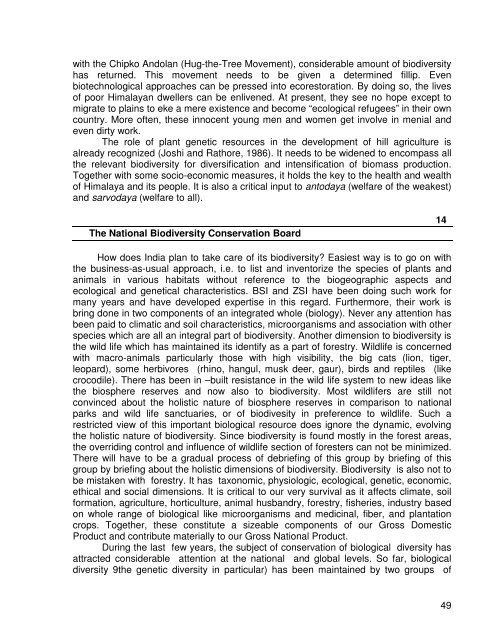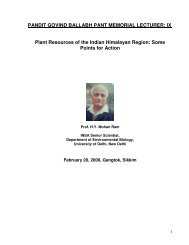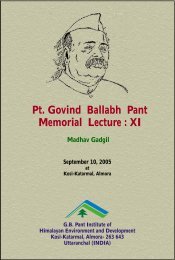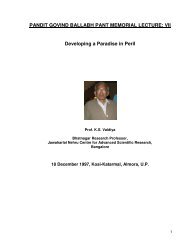Pandit Govind Ballabh Pant Memorial Lecture: II
Pandit Govind Ballabh Pant Memorial Lecture: II
Pandit Govind Ballabh Pant Memorial Lecture: II
You also want an ePaper? Increase the reach of your titles
YUMPU automatically turns print PDFs into web optimized ePapers that Google loves.
with the Chipko Andolan (Hug-the-Tree Movement), considerable amount of biodiversity<br />
has returned. This movement needs to be given a determined fillip. Even<br />
biotechnological approaches can be pressed into ecorestoration. By doing so, the lives<br />
of poor Himalayan dwellers can be enlivened. At present, they see no hope except to<br />
migrate to plains to eke a mere existence and become “ecological refugees” in their own<br />
country. More often, these innocent young men and women get involve in menial and<br />
even dirty work.<br />
The role of plant genetic resources in the development of hill agriculture is<br />
already recognized (Joshi and Rathore, 1986). It needs to be widened to encompass all<br />
the relevant biodiversity for diversification and intensification of biomass production.<br />
Together with some socio-economic measures, it holds the key to the health and wealth<br />
of Himalaya and its people. It is also a critical input to antodaya (welfare of the weakest)<br />
and sarvodaya (welfare to all).<br />
The National Biodiversity Conservation Board<br />
14<br />
How does India plan to take care of its biodiversity? Easiest way is to go on with<br />
the business-as-usual approach, i.e. to list and inventorize the species of plants and<br />
animals in various habitats without reference to the biogeographic aspects and<br />
ecological and genetical characteristics. BSI and ZSI have been doing such work for<br />
many years and have developed expertise in this regard. Furthermore, their work is<br />
bring done in two components of an integrated whole (biology). Never any attention has<br />
been paid to climatic and soil characteristics, microorganisms and association with other<br />
species which are all an integral part of biodiversity. Another dimension to biodiversity is<br />
the wild life which has maintained its identify as a part of forestry. Wildlife is concerned<br />
with macro-animals particularly those with high visibility, the big cats (lion, tiger,<br />
leopard), some herbivores (rhino, hangul, musk deer, gaur), birds and reptiles (like<br />
crocodile). There has been in –built resistance in the wild life system to new ideas like<br />
the biosphere reserves and now also to biodiversity. Most wildlifers are still not<br />
convinced about the holistic nature of biosphere reserves in comparison to national<br />
parks and wild life sanctuaries, or of biodivesity in preference to wildlife. Such a<br />
restricted view of this important biological resource does ignore the dynamic, evolving<br />
the holistic nature of biodiversity. Since biodiversity is found mostly in the forest areas,<br />
the overriding control and influence of wildlife section of foresters can not be minimized.<br />
There will have to be a gradual process of debriefing of this group by briefing of this<br />
group by briefing about the holistic dimensions of biodiversity. Biodiversity is also not to<br />
be mistaken with forestry. It has taxonomic, physiologic, ecological, genetic, economic,<br />
ethical and social dimensions. It is critical to our very survival as it affects climate, soil<br />
formation, agriculture, horticulture, animal husbandry, forestry, fisheries, industry based<br />
on whole range of biological like microorganisms and medicinal, fiber, and plantation<br />
crops. Together, these constitute a sizeable components of our Gross Domestic<br />
Product and contribute materially to our Gross National Product.<br />
During the last few years, the subject of conservation of biological diversity has<br />
attracted considerable attention at the national and global levels. So far, biological<br />
diversity 9the genetic diversity in particular) has been maintained by two groups of<br />
49











